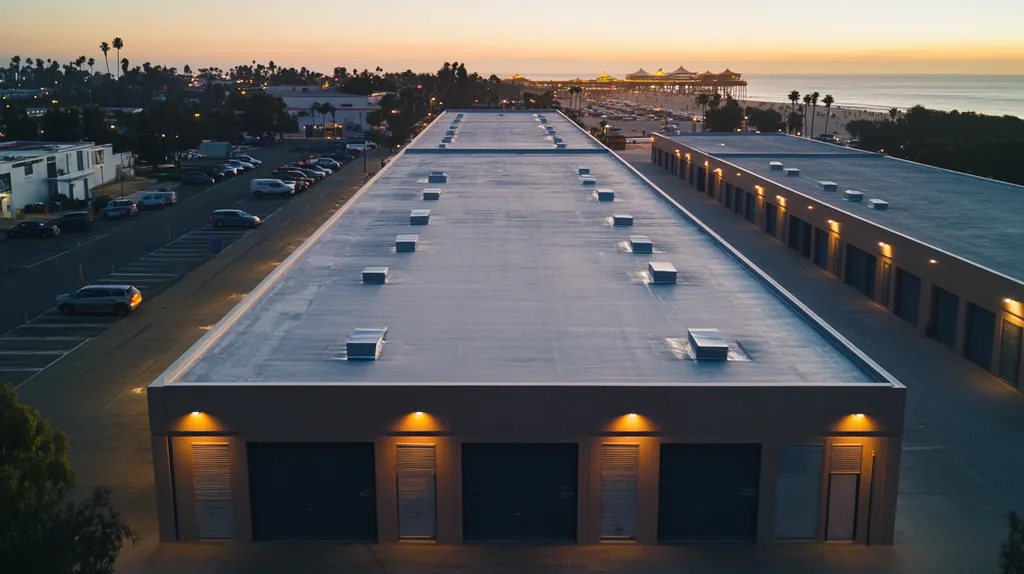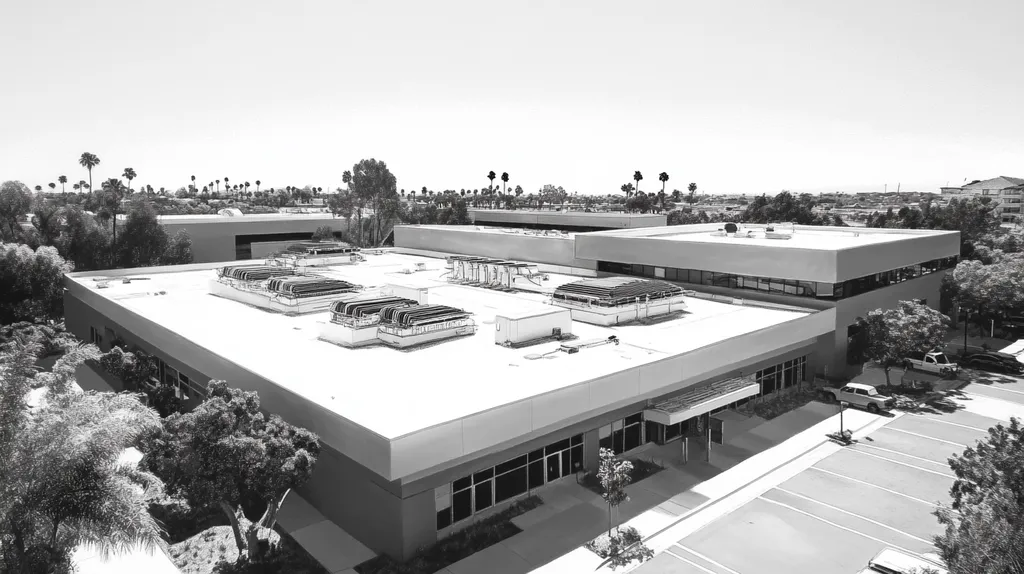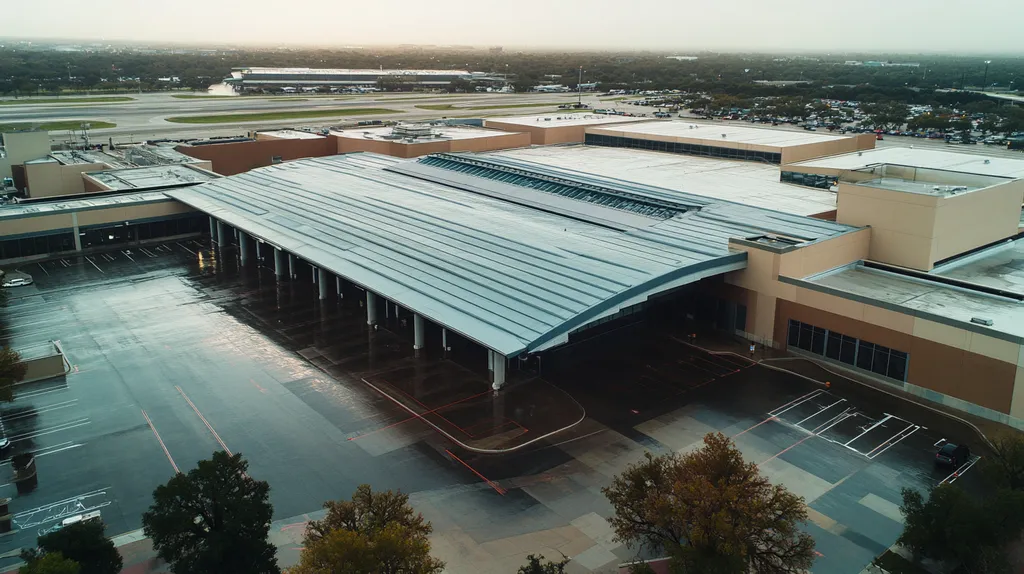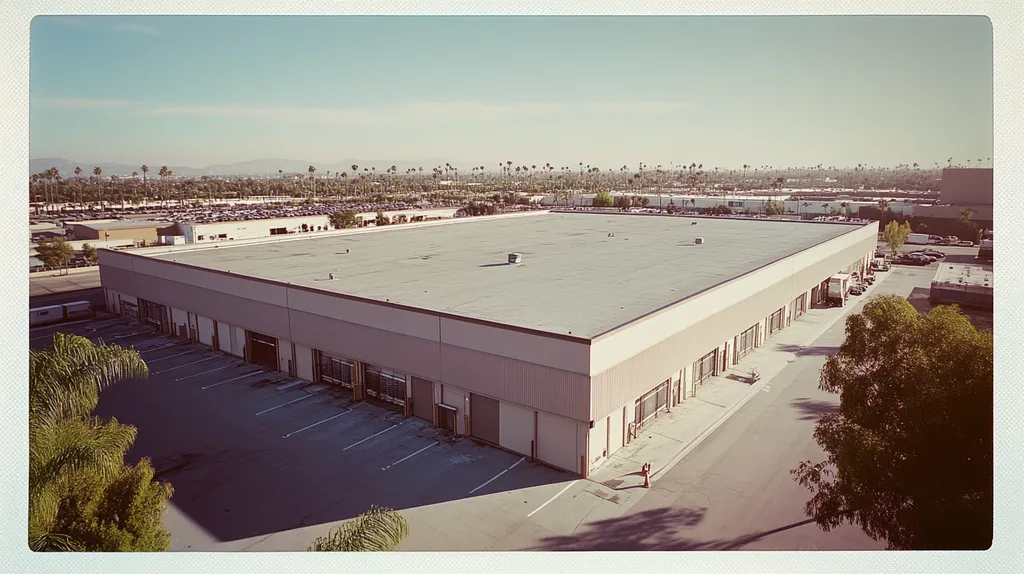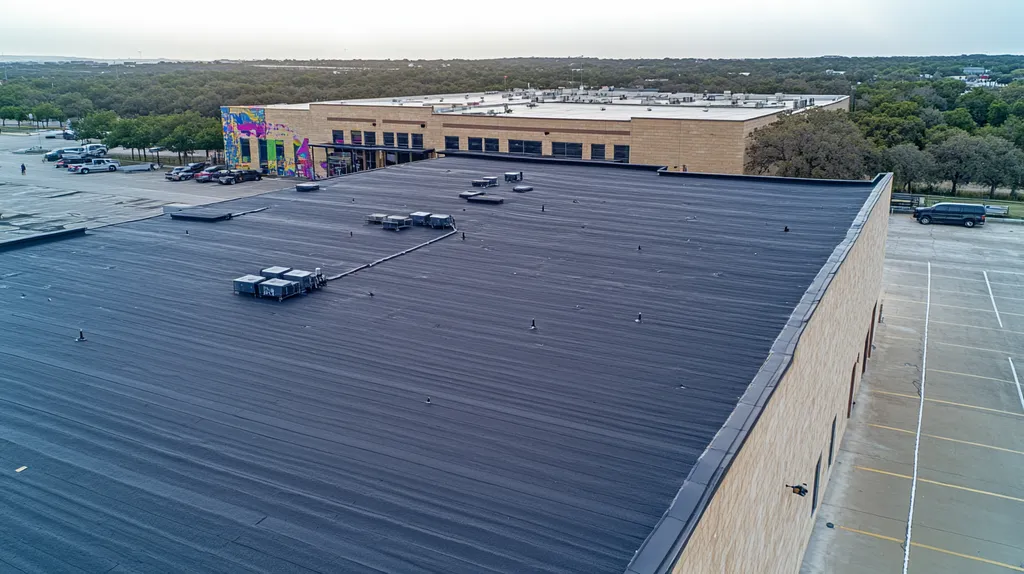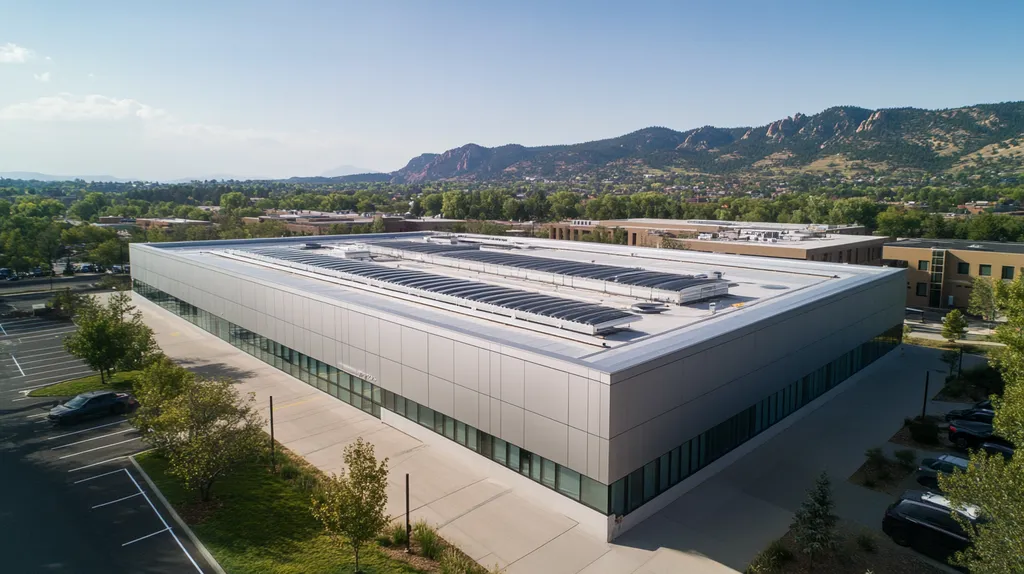In commercial roofing, ventilation failures contribute to over $1.2 billion in annual coating damage across North America. Despite this staggering figure, many property owners continue to rely on outdated assumptions about roof ventilation that compromise coating performance.
Recent industry studies reveal that 78% of premature coating failures stem from inadequate airflow and moisture control, leading to costly repairs and shortened roof lifespans.
This analysis challenges long-held beliefs about commercial roof ventilation, examining how current practices fall short and exploring data-driven solutions that protect coating integrity while maximizing building efficiency.
SECTION 1: CURRENT PRACTICES
The performance of a commercial roof hinges significantly on proper ventilation. When ventilation systems fail to function effectively, the consequences can be severe: roofs may experience irreversible damage, leading to expensive repairs and shortened lifespans. Alarmingly, nearly 90% of roofing professionals highlight inadequate ventilation as a primary factor in roof deterioration. By understanding current ventilation practices, property owners can help safeguard the longevity and performance of their roofing systems and coatings.
Standard Ventilation Systems in Use
Most commercial roofs depend on standard ventilation systems designed to regulate temperature and moisture. These systems typically include both intake and exhaust vents, positioned strategically to optimize airflow throughout the building.
Passive ventilation systems are common; they use natural forces to allow warm air to rise and escape. However, many buildings benefit from mechanical systems featuring fans that actively circulate air, enhancing efficiency and climate control.
The ultimate aim of these systems is to mitigate heat buildup and moisture retention, which are critical factors that can lead to damage. Yet the efficiency of these systems can vary widely, influenced by their installation and the specific environmental conditions of the building.
As commercial architecture evolves, there is a burgeoning need for customized solutions. Adapting standard systems to fit distinct roof types and usage patterns is vital for maximizing their performance.
Common Ventilation Components and Their Roles
To grasp how ventilation systems contribute to roof performance, it’s essential to understand their basic components. Typically, these systems include vents, fans, and ductwork, each serving a specific function.
Intake vents work to draw in fresh air, while exhaust vents expel stale air, ensuring balanced airflow for optimal performance. Ridge vents, found at the roof’s peak, are key for encouraging the escape of rising hot air.
Fans, particularly powered exhaust fans, play a critical role in boosting circulation, especially during humid months. They can effectively reduce localized heat buildup, which not only enhances comfort but also improves energy efficiency.
Proper integration and functioning of all components are crucial. Overlooking any part of this system can result in hotspots, accelerating deterioration and diminishing the lifespan of roofing materials.
Typical Installation and Maintenance Practices
How ventilation systems are installed can greatly affect their overall performance and longevity. Incorrect placement or sizing of vents may lead to inefficiencies, which invite moisture problems.
Regular inspections are vital for ensuring all components are operating properly. Maintenance routines should include cleaning debris from vents and verifying that fans are functioning; these steps can prevent declines in performance.
Property owners should also consider how the changing weather impacts their ventilation systems. For example, snow and ice can obstruct vents, making seasonal inspection critical.
By committing to a regular maintenance schedule, property owners can significantly extend the life of their roofs and the coatings applied to them, leading to substantial cost savings over time.
SECTION 2: SYSTEMIC ISSUES
Today’s commercial roofing systems are frequently challenged by performance issues stemming from inadequate ventilation. Poorly regulated moisture and temperature can lead to serious roofing failures and costly repairs for property owners. Alarmingly, the National Roofing Contractors Association (NRCA) indicates that moisture-related damage repairs can cost up to six times more than taking preventive action. It’s essential to address the systemic issues that exacerbate these challenges to protect investments and ensure long-lasting roofing solutions.
Inadequate Moisture Control Mechanisms
Effective moisture control is crucial to sustaining the durability of roofing systems. Without proper management strategies, moisture can accumulate beneath roof coatings, triggering blisters and peeling. Research has shown that poor drainage and insufficient ventilation are significant culprits behind trapped moisture, resulting in compromised roof coatings.
In addition, condensation can form during temperature swings, particularly in high humidity climates. This hidden moisture often goes unnoticed during inspections and, if ignored, fosters an environment conducive to mold and mildew growth, which can further jeopardize the roofing structure.
To avoid hefty repair costs in the future, property owners must place a strong emphasis on moisture control. Implementing proper ventilation solutions facilitates drying and minimizes moisture buildup, ultimately protecting roofing investments.
Neglecting moisture management does not only impair coating performance but can also void manufacturer warranties. It’s time to shift the focus from mere aesthetics to the functional longevity of roofing systems.
Insufficient Temperature Regulation Methods
Temperature regulation is essential for the longevity of roof coatings. When roofing surfaces heat up excessively, they expand and can degrade rapidly. Studies have shown that roofs lacking adequate ventilation can experience surface temperatures much higher than the surrounding air, leading to premature coating failure.
Excessive heat can warp or crack roofing materials, creating additional deterioration not only in coatings but throughout the entire roofing system. The stresses from thermal expansion and contraction can harm seals and joints, worsening the risk of leaks.
By employing effective temperature control through improved ventilation, these issues can be mitigated, enhancing roof durability. Properly designed systems expel warm air from the roof surface, preserving ideal conditions for coatings.
Now is the time for property owners to embrace advanced temperature regulation techniques to safeguard their assets. Innovative ventilation solutions can significantly bolster the performance and lifespan of roof coatings, providing enhanced protection against extreme temperatures.
Energy Efficiency Shortfalls in Current Systems
Many existing commercial roofing systems rely on outdated practices, leading to a lack of energy efficiency. Poorly ventilated roofs fail to maintain optimal thermal performance, resulting in inflated energy costs. When inadequate insulation combines with subpar ventilation, heating and cooling expenses can skyrocket.
The Department of Energy states that proper roof ventilation can decrease energy costs by as much as 30%. Yet, many property owners remain unaware of how their roofing systems can impact overall energy efficiency.
This oversight creates a cycle of diminishing returns, where improper ventilation hampers roof performance and increases operational costs. Addressing systemic ventilation issues can unlock substantial financial savings for property owners.
Investing in energy-efficient ventilation solutions will bring long-term rewards. With rising energy expenses and increasing environmental concerns, property owners must recognize the vital connection between roofing performance and energy efficiency.
SECTION 3: MISSED OPPORTUNITIES
Ignoring the crucial role of ventilation in enhancing roof coating performance can result in significant setbacks for property owners. Poor airflow can lead to costly repairs and premature roof failures. Research indicates that as many as 30% of commercial roofs face coating failures due to inadequate ventilation practices. This section delves into crucial oversights in commercial roofing that jeopardize long-term outcomes and investment protection.
Overlooking the Importance of Balanced Airflow
Balanced airflow is essential for preserving the integrity of roof coatings. When ventilation is insufficient, heat and moisture accumulate beneath the roof surface, causing blisters and peeling. This not only endangers the coating but also threatens the roof structure beneath it.
For example, buildings lacking adequate intake or exhaust vents often see internal temperatures rise. This excess heat accelerates the degradation of coatings, leading to increased replacement costs. Property owners frequently overlook these ventilation needs while prioritizing insulation values.
Furthermore, varying climatic conditions necessitate tailored ventilation strategies. This is particularly true for buildings in humid climates, which require different airflow management compared to those in arid regions. Ignoring these specific needs can result in significant performance failures and costly remediation.
Ultimately, property owners need to recognize that ensuring balanced airflow is not just a recommendation; it is vital for maximizing the lifespan and effectiveness of roof coatings.
Neglecting Regular Inspections and Maintenance
Regular inspections and maintenance are often disregarded, leading to missed opportunities for enhancing roof performance. Many facility managers incorrectly assume that new roof coatings will function perfectly without subsequent care, contributing to serious long-term issues, including moisture damage and premature wear.
Studies indicate that routine inspections can prolong a roof’s lifespan by identifying ventilation issues early on. For instance, checking vents for obstructions can prevent moisture buildup, which threatens coating durability.
Additionally, failing to prioritize maintenance includes neglecting the removal of debris from roof vents. Leaves and dirt can block airflow, creating hotspots that accelerate roof coating degradation. Regular cleaning not only promotes necessary airflow but also improves overall roof health.
In summary, overlooking inspections and maintenance is a significant missed opportunity that can lead to extensive roof damage and higher costs in the long run.
Failing to Optimize Ventilation for Specific Building Needs
Each commercial building presents unique challenges, yet many property owners apply a one-size-fits-all method to ventilation. This approach can be fiscally detrimental, as improper ventilation fails to address specific operational needs or configurations.
For instance, warehouses storing humidity-sensitive products require distinct ventilation strategies compared to standard office buildings. Recognizing the specific demands of each building type is critical for achieving effective roof performance and longevity.
Moreover, buildings involved in manufacturing processes that generate heat or moisture need customized ventilation systems. Generic designs often fail to adequately manage these factors, resulting in excessive wear on roof coatings.
To enhance performance, property owners should consult with roofing professionals capable of assessing building types, usage, and environmental conditions. This customized approach will not only improve overall efficiency but also bolster the protective capabilities of roof coatings.
In conclusion, failing to tailor ventilation solutions represents a missed opportunity that could maximize the benefits of roof coatings across diverse commercial properties.
SECTION 4: ROOT CAUSES
The effectiveness of roof coatings is heavily influenced by the ventilation design of each building. When ventilation is inadequate, moisture and heat can build up, resulting in diminished coating lifespan. Research shows that almost 70% of roofing failures can be traced back to poor ventilation practices, leading to costly repairs and operational inefficiencies. This section will uncover the fundamental root causes behind these issues, underscoring the importance of customized solutions over standard approaches.
Lack of Customized Ventilation Designs
Numerous commercial properties continue to employ one-size-fits-all ventilation systems, overlooking the distinct characteristics of each building. Every structure has unique requirements based on its design, usage, and geographical location. When a standard approach is utilized, it can result in poor air circulation, allowing moisture to seep in and compromise roof coatings.
Customized ventilation designs consider critical factors such as roof height, occupancy, and local climate. For instance, a low-slope industrial facility situated in a humid climate will need more exhaust vents than a flat commercial building in a dry zone. Failure to adapt to these individual needs threatens the performance of coatings and diminishes the efficacy of the entire roofing system.
The absence of tailored designs often leads to imbalanced air pressure, fostering hotspots that accelerate material wear and tear. As roof coatings deteriorate prematurely, property owners face significant financial losses and operational disruptions. Investing in customized ventilation solutions enhances coating performance, leading to extended roof lifespans and reduced maintenance expenses. A reassessment of existing designs is necessary to prioritize more individualized approaches.
Inadequate Training for Installation and Maintenance
Ensuring proper installation and maintenance of ventilation systems is vital for their long-term effectiveness. Unfortunately, many contractors do not receive the training necessary to execute these tasks properly, leading to common errors that hinder performance. For example, poorly sealed vents can cause air leaks that significantly reduce the efficiency of the system.
Without comprehensive training, contractors may overlook established ventilation techniques that are crucial to preventing moisture buildup and facilitating proper airflow. Studies indicate that buildings maintained by trained professionals enjoy a substantially longer lifespan for roofing materials than those that are not. This highlights the critical need for knowledgeable installation and upkeep.
Furthermore, routine maintenance often suffers from a lack of training and understanding of ventilation systems. Property owners may not recognize how essential regular inspections are for maintaining roofing integrity. Neglecting ventilation upkeep can lead to worsening air quality, moisture issues, and consequential damage to roofing materials.
To address this issue, improving educational programs for installers and maintenance staff is crucial. By emphasizing the intricacies of ventilation, the industry can boost the overall performance of roofing systems and help property owners protect their investments.
Ignoring Building-Specific Factors and Climate
Each building carries unique traits and environmental factors that affect its ventilation needs. However, many ventilation strategies fail to account for these critical elements. For instance, a property located along the coast faces different environmental conditions than one found inland, and neglecting these nuances can lead to moisture stagnation and heightened risk of mold under roofing materials.
Overlooking climate-related factors not only weakens coating effectiveness but can also create health risks for occupants. Additionally, local regulations may dictate particular ventilation requirements based on environmental conditions. Ignoring these mandates can result in compliance challenges and potential fines, making it imperative for property owners to stay informed and proactive.
Recognizing and addressing the specifics of each building—including its climate and local regulations—enables property owners to mitigate ventilation inefficiencies. This informed approach enhances the preservation of roofing materials, ultimately maximizing the benefits of their commercial roofing investments.
DATA DRIVEN EVIDENCE
The consequences of inadequate roof ventilation can resonate across a commercial property, impacting everything from energy costs to the longevity of roofing systems. Ineffective ventilation doesn’t just raise operational expenses; it can lead to premature roof failures that severely disrupt building performance. For instance, studies reveal that roofs lacking proper ventilation can see energy consumption grow by as much as 30%. This section explores how ventilation affects energy usage and costs, examines case studies illustrating premature roof deterioration, and outlines the measurable benefits of implementing effective ventilation systems.
Statistical Impact on Energy Consumption and Costs
For commercial properties, energy consumption plays a crucial role in determining overall operating costs. When roofs are poorly ventilated, they often trap heat, forcing HVAC systems to work overtime to maintain comfortable indoor temperatures. Recent industry data shows that properties with optimized ventilation can achieve a remarkable 25% reduction in cooling costs.
This statistic translates into significant savings over time. For example, a building spending $10,000 annually on cooling could cut costs by as much as $2,500 each year with the right ventilation strategies in place. This becomes even more essential in regions experiencing extreme temperatures, where the demand for effective cooling escalates.
Beyond cost savings, these energy efficiencies contribute to a reduced carbon footprint, fulfilling a dual goal of economic and environmental sustainability. Enhancing ventilation not only aids the bottom line but also helps create a more sustainable future for our communities.
By analyzing utility bills and energy reports, property managers can gain insights into how their ventilation systems influence overall energy costs, leading to data-driven decisions that can result in improved financial outcomes.
Case Studies on Premature Roof Deterioration
Analyzing real-world case studies sheds light on the far-reaching effects of neglecting roof ventilation. In one notable example, a 150,000-square-foot manufacturing facility suffered severe moisture buildup due to inadequate ventilation. This oversight led to a staggering 40% decline in the roof’s lifespan, necessitating costly repairs just five years post-installation.
Another case involved a retail space where unventilated roofs fostered the rapid development of mold and mildew. The direct impacts included compromised structural integrity and the temporary closure of the business for remediation, resulting in lost revenue. Evaluating these incidents reveals that the financial ramifications of insufficient ventilation can vastly exceed the costs associated with implementing the necessary ventilation systems.
These examples reinforce the importance of proactive measures in roof design. Implementing adequate ventilation strategies can drastically extend roofing systems’ lifespan and help safeguard investments while ensuring business continuity.
Quantitative Benefits of Proper Ventilation Systems
The overwhelming quantitative benefits of effective ventilation systems are compelling. Research indicates that a well-planned ventilation system can increase a roof’s life expectancy by as much as 50%. This improvement translates into significant lifecycle savings by minimizing the need for early replacements and repairs.
In one study, facilities that adopted advanced ventilation techniques not only experienced enhanced roof health but also enjoyed better indoor air quality. Poor air circulation can elevate humidity levels, jeopardizing both the roof and the building’s interior environment.
Additionally, effective ventilation allows for optimized energy management. With proper airflow, heating and cooling systems can operate more efficiently, leading to reduced utility bills and decreased greenhouse gas emissions.
Investing in robust ventilation solutions pays dividends. Property owners prioritizing proper ventilation are positioned to reap the dual rewards of cost savings and increased property value. This data-driven evidence underscores that effective roof ventilation is not merely an option—it is essential for sustainable and economical building management.
SECTION 6: ALTERNATIVE SOLUTIONS
In an era where roofing performance is under renewed scrutiny, it is crucial for property owners to challenge outdated practices. Ineffective ventilation not only invites premature coating failures but also leads to mounting repair costs. By embracing advanced technologies and synergizing ventilation with insulation, building owners can significantly bolster both roof longevity and overall performance. This section outlines forward-thinking alternative solutions aimed at addressing these pressing challenges.
Implementing Advanced Ventilation Technologies
Advanced ventilation technologies are fundamentally reshaping the commercial roofing landscape. Dynamic ventilation systems, for instance, can automatically adjust airflow based on real-time temperature and humidity levels, creating optimal conditions for roofing materials.
Electrically controlled ridge vents and powered exhaust systems exemplify this innovation. These systems can react to unfavorable conditions, effectively preventing moisture accumulation that can lead to severe damage such as coating delamination.
By investing in these technologies, property owners not only protect their roofs but also boost energy efficiency. A balanced indoor environment can substantially reduce energy costs while prolonging roof life, presenting a clear advantage for building owners.
As property owners consider upgrades or replacements, evaluating these cutting-edge solutions is essential. The long-term economic benefits of decreased maintenance costs and enhanced durability far outweigh the initial investment.
Integrating Ventilation with Insulation Systems
The integration of ventilation with insulation systems creates a powerful synergy that enhances roof performance. Effective insulation stabilizes temperature fluctuations, while adequate ventilation effectively removes excess moisture, preventing damage to roofing materials.
For example, pairing reflective insulation with strategically designed vents helps maintain cooler building temperatures while facilitating moisture expulsion. This not only protects the roof but also fosters a healthier indoor environment, aligning with the rising expectations in commercial spaces.
Building owners should prioritize designing roofs that encourage this harmonious interaction. The right combinations of insulation and ventilation can lead to notable long-term savings and improved reliability of roofing coatings.
Additionally, these integrated systems can bolster compliance with energy performance regulations, potentially qualifying properties for green building certifications, enhancing their appeal in an eco-conscious marketplace.
Collaborating with Expert Roofing Contractors for Custom Solutions
Engaging with seasoned roofing contractors is vital for crafting tailored ventilation solutions. These professionals possess insights into specific building requirements and local climate conditions, enabling customized approaches that address unique challenges.
Investing in collaboration can unlock innovative roofing strategies that traditional methods may overlook. For example, experienced contractors can recommend optimal vent positions or alternative materials that enhance airflow and overall roof performance.
This partnership fosters a culture of knowledge sharing, allowing property owners to stay updated on the latest advancements in ventilation techniques and materials. As a result, roofing systems are more likely to align with current industry standards, which can extend their lifespan.
Facility managers should actively cultivate relationships with these experts. Informed decisions about ventilation can lead to substantial operational efficiencies and cost savings, significantly influencing the performance and integrity of commercial roofs.
Moving Forward
The data is clear: inadequate ventilation leads to over $1.2 billion in annual coating damage across commercial properties, yet 78% of facilities continue operating with suboptimal systems.
This systematic failure to address ventilation represents both a crisis and an opportunity for the commercial roofing industry.
By implementing advanced ventilation technologies, integrating sophisticated insulation systems, and partnering with qualified contractors, property owners can extend roof coating life by up to 50% while reducing energy costs by 30%.
The time for relying on outdated assumptions has passed – protecting these vital assets requires immediate action through data-driven solutions and proactive maintenance strategies.
The future of commercial roofing depends on recognizing ventilation as a critical factor in coating performance and overall building efficiency.
FREQUENTLY ASKED QUESTIONS
Q. How does poor ventilation affect a commercial roof’s lifespan?
A. Inadequate ventilation can lead to excessive heat and trapped moisture, causing roof damage. This can result in costly repairs and significantly shorten the lifespan of the roof and its coatings. Addressing ventilation issues early can help prolong the roof’s health and performance.
Q. What systemic issues should I address in my industrial roof?
A. Focus on moisture management and temperature regulation as key systemic issues. Inadequate moisture control can lead to significant damage, while poor temperature regulation can cause rapid material degradation. Improving these aspects can protect your roofing system and extend its life.
Q. Why is balanced airflow crucial for commercial roofs?
A. Balanced airflow prevents heat and moisture build-up that can cause roof coating failures. Without it, you risk damaging the roof structure and incurring extra replacement costs. Ensuring adequate intake and exhaust vents is essential for optimal roof performance.
Q. What are the root causes of ventilation problems in commercial roofing?
A. Root causes often include lack of customized ventilation designs and inadequate training for installers. Many buildings use standard systems not suited for their specific conditions, leading to poor airflow and moisture issues. Proper assessment and tailored solutions can improve roofing performance.
Q. How can ventilation affect energy costs for a commercial property?
A. Proper ventilation reduces energy consumption by preventing heat buildup, allowing HVAC systems to work more efficiently. Studies indicate that improved ventilation can lower cooling costs by up to 25%. This leads to significant savings on energy bills over time.
Q. What advanced technologies can improve roof ventilation?
A. Advanced technologies like dynamic ventilation systems can automatically adjust airflow based on environmental conditions. Electrically powered systems enhance moisture management and improve energy efficiency, helping to protect the roofing materials and potentially lowering maintenance costs.
Q. Why should I collaborate with roofing contractors for ventilation solutions?
A. Collaborating with experienced contractors ensures tailored ventilation designs that meet your building’s unique needs. They provide valuable insights into optimal vent placement and materials, ultimately enhancing roof performance and helping maximize your investment in roofing systems.

